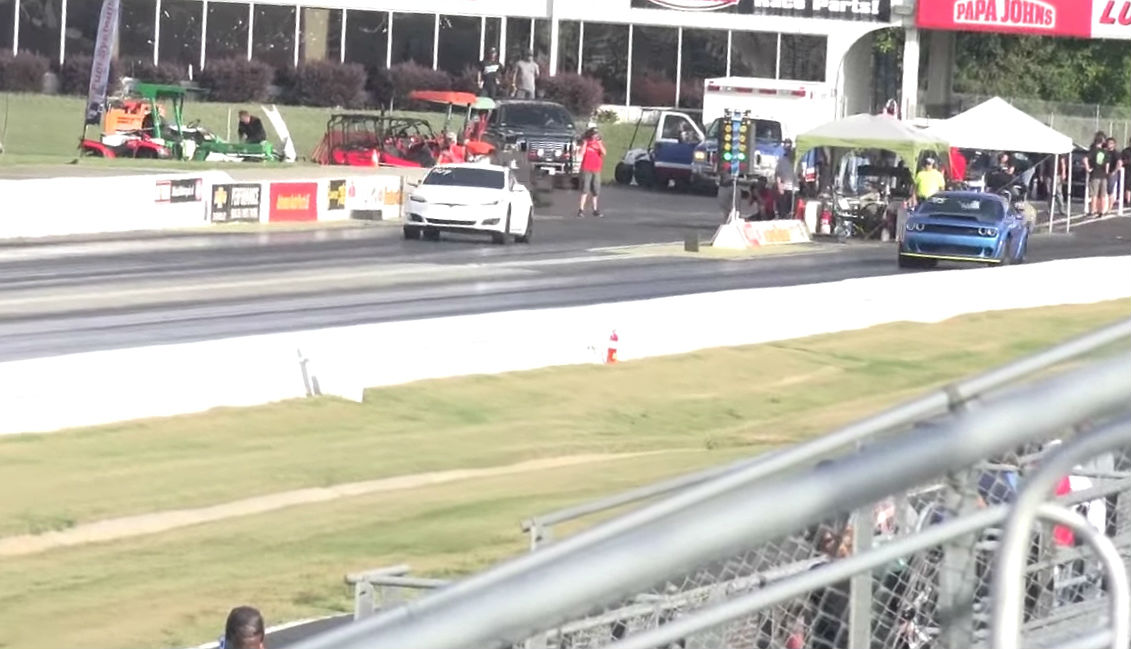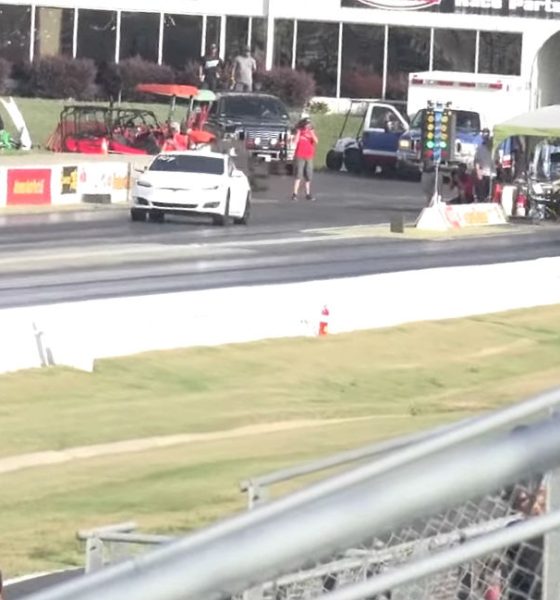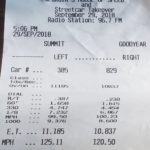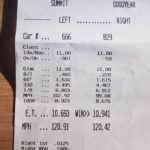

Lifestyle
Tesla Model S P100D slays twin Dodge Challenger SRT Demons in drag race
There is something satisfying about seeing two incredibly powerful cars taking on each other at the drag strip. In the case of the Tesla Model S P100D and the Dodge Challenger SRT Demon, any battle involving these two vehicles are always bound to be compelling. This is because the two vehicles have quite a lot of history between them.
Back in February 2017, auto publication Motor Trend crowned the Tesla Model S P100D with Ludicrous Mode as the first production car that was able to break the 2.3-second barrier. In the publication’s test, the all-electric family sedan was able to hit the 60 mph mark in precisely 2.275507139 seconds. A few months after this, Dodge took the wraps off its premier muscle car, the Dodge Challenger SRT Demon, a vehicle designed to dominate the drag strip completely. During the Demon’s unveiling, Dodge executives noted that the 840-hp monster (808 hp without 100 octane racing fuel) would be quicker from 0-60 than the Tesla Model S P100D. Dodge also revealed the Demon’s performance results in the quarter-mile, and they were nothing short of incredible. Zero to 60 in 2.1 seconds, 0-100 mph in 5.1 seconds, and a quarter-mile time of 9.65 seconds at 140 mph.
As later bouts with the Model S P100D would later show, pulling out all the potential of the Dodge Demon takes a very skilled driver and a particular set of conditions. This was evident during Dodge’s 2.1-second 0-60 run, which was conducted on a regulation drag strip that was coated with sticky resin. This gave the monster muscle car extra grip, preventing it from spinning out and losing precious milliseconds. Motor Trend‘s test of the P100D, on the other hand, was conducted on regular dry asphalt.
Thus, if conditions are preferable, and if the Dodge Demon hooks, it should have no problem beating the Model S P100D. As a recent video from the Tesla Racing Channel would show, the Model S P100D won’t go down easily even if the Dodge Demon does not run into any traction issues.
Tesla Racing Channel has been around for a while, at one point even racing with a gutted Model S P100D, which was able to stand toe-to-toe even with the most extreme fossil fuel-powered drag cars. This time around, though, the veteran electric racer took a stock Model S P100D to the track, to see how well it does on bracket racing. Bracket Racing is a form of drag racing that places a premium on the consistency of the driver and car’s performance. To win in Bracket Races, drivers need to excel in reaction times, as well as hitting the finish line as close to their dial-in time as possible. In the case of Model S P100D and the Dodge Demon, the drivers opted for a dial-in time of 11.0 seconds.
- Tesla Model S P100D vs Dodge Demon drag race results. [Credit: Tesla Racing Channel/YouTube]
- Tesla Model S P100D vs Dodge Demon drag race results. [Credit: Tesla Racing Channel/YouTube]
Tesla Model S P100D vs Dodge Demon drag race results. [Credit: Tesla Racing Channel/YouTube]
The first race involved the Model S P100D completely dominating the Dodge Demon, crossing the finish line at 10.837 seconds (0.163 seconds off the dial-in time). The Demon, for its part, crossed the quarter-mile mark in 11.185 seconds (0.185 seconds off the dial-in time). The Dodge Demon in the next race actually performed better, catching up to the Model S P100D midway through the race. The Demon’s driver seemed to have gotten a bit overexcited, though, causing the muscle car to “break-out.” Breaking out happens when a racer crosses the finish line in less time than the dial-in time. This happened to the second Demon’s driver, who missed the 11.0 dial-in time by 0.307 seconds. Exhibiting his veteran drag racing skills, the Model S P100D driver actually braked close to the finish line, crossing the quarter-mile mark in 10.941 seconds, just 0.059 seconds off the dial-in time.
Overall, the Model S P100D’s recent races with the twin Dodge Demons exhibited just how quick and consistent Tesla’s electric cars are in terms of their performance. With an experienced driver behind the wheel, even Tesla’s family sedan becomes a monster of its own on the drag strip – one that takes a perfect set of conditions and a perfect setup to beat.
Watch Tesla Racing Channel‘s battle with the twin Dodge Challenger SRT Demons in the video below.

Lifestyle
Tesla Model S Plaid battles China’s 1500 hp monster Nurburgring monster, with surprising results
There is just something about Tesla’s tuning and refinement that makes raw specs seem not as game-changing.

The Tesla Model S Plaid has been around for some time. Today, it is no longer the world’s quickest four-door electric sedan, nor is it the most powerful. As per a recent video from motoring YouTube channel Carwow, however, it seems like the Model S Plaid is still more than a match for some of its newer and more powerful rivals.
The monster from China
The Xiaomi SU7 Ultra is nothing short of a monster. Just like the Model S Plaid, it features three motors. It also has 1,548 hp and 1,770 Nm of torque. It’s All Wheel Drive and weighs a hefty 2,360 kg. The vehicle, which costs just about the equivalent of £55,000, has been recorded setting an insane 7:04.957 at the Nurburgring, surpassing the previous record held by the Porsche Taycan Turbo GT.
For all intents and purposes, the Model S Plaid looked outgunned in Carwow’s test. The Model S Plaid is no slouch with its three motors that produce 1,020 hp and 1,420 Nm of torque. It’s also a bit lighter at 2,190 kg despite its larger size. However, as the Carwow host pointed out, the Model S Plaid holds a 7:25.231 record in the Nurburgring. Compared to the Xiaomi SU7 Ultra’s record, the Model S Plaid’s lap time is notably slower.
Real-world tests
As could be seen in Carwow’s drag races, however, Tesla’s tech wizardry with the Model S Plaid is still hard to beat. The two vehicles competed in nine races, and the older Model S Plaid actually beat its newer, more powerful counterpart from China several times. At one point in the race, the Xiaomi SU7 Ultra hit its power limit due to its battery’s temperature, but the Model S Plaid was still going strong.
The Model S Plaid was first teased five years ago, in September 2020 during Tesla’s Battery Day. Since then, cars like the Lucid Air Sapphire and the Xiaomi SU7 Ultra have been released, surpassing its specs. But just like the Model Y ended up being the better all-rounder compared to the BYD Sealion 7 and the MG IM6, there is just something about Tesla’s tuning and refinement that makes raw specs seem not as game-changing.
Check out Carwow’s Model S Plaid vs Xiaomi SU7 drag race video below.
Lifestyle
500-mile test proves why Tesla Model Y still humiliates rivals in Europe
On paper, the BYD Sealion 7 and MG IM6 promised standout capabilities against the Model Y.

BYD is seeing a lot of momentum in Europe, so much so that mainstream media has taken every opportunity to argue that the Chinese automaker has beaten Tesla in the region. But while BYD sales this year in Europe are rising and Tesla’s registrations remain challenged, the raw capabilities of vehicles like the Model Y are difficult to deny.
This was highlighted in a 500-mile challenge by What Car? magazine, which showed that the new Tesla Model Y is more efficient, cheaper to run, and more reliable than rivals like the BYD Sealion 7, and even the nearly 400 KW-charging MG IM6.
Range and charging promises
On paper, the BYD Sealion 7 and MG IM6 promised standout capabilities against the Model Y. The Sealion 7 had more estimated range and the IM6 promised significantly faster charging. When faced with real-world conditions, however, it was still the Model Y that proved superior.
During the 500-mile test, the BYD nearly failed to reach a charging stop, arriving with less range than its display projected, as noted in a CarUp report. MG fared better, but its charging speeds never reached its promised nearly-400 kW charging speed. Tesla’s Model Y, by comparison, managed energy calculations precisely and arrived at each stop without issue.
Tesla leads in areas that matter
Charging times from 25% to 80% showed that the MG was the fastest at 17 minutes, while Tesla and BYD were close at 28 and 29 minutes, respectively. Overall efficiency and cost told a different story, however. The Model Y consumed 19.4 kWh per 100 km, compared to 22.2 for MG and 23.9 for BYD. Over the full trip, Tesla’s charging costs totaled just £82 thanks to its supercharger network, far below BYD’s £130 and MG’s £119.
What Car? Magazine’s testers concluded that despite BYD’s rapid sales growth and the MG IM6’s seriously impressive charging speeds, Tesla remains the more compelling real-world choice. The Model Y just offers stability, efficiency, and a proven charging infrastructure through its Supercharging network. And as per the magazine’s hosts, the Model Y is even the cheapest car to own among the three that were tested.
Watch What Car? Magazine’s 500-mile test in the video below.
Lifestyle
Tesla Cybertruck slapped with world’s least intimidating ticket, and it’s pure cringe
One cannot help but cringe and feel second-hand embarrassment at the idea of a person just driving around with a stack of these babies.

A Cybertruck parked at Stanford Shopping Center in California was recently hit with what might be the most try-hard piece of paper ever slipped under a wiper blade: a “fake citation” accusing the driver of supporting a “fascist car.”
The note, shared on X by Tesla staff program manager Ryan Torres, quickly made the rounds on X, where it quickly gained attention as an example of how not to protest.
The world’s least intimidating ticket
According to the citation, the supposed “violation” was “driving a fascist car.” The remedial action? Take the bus, call an Uber, or ride a bike. The note also dubbed Elon Musk a “chainsaw-wielding Nazi billionaire.” Now, protests against Tesla and Elon Musk have become commonplace this year, but one cannot help but cringe and feel second-hand embarrassment at the idea of a person just driving around with a stack of fake anti-Tesla/Musk citations.
Torres pointed out the irony himself in his post on X. Tesla currently employs over 140,000 Americans, and SpaceX has put the U.S. firmly back at the top of space technology. As Torres put it, maybe the person behind the world’s least intimidating ticket should “read a book on innovation before vandalizing” other people’s property.
Peak performative clownery
Not to mention that the fake ticket’s logic collapses under its own weight. EVs like the Cybertruck are literally designed to reduce emissions, not “destroy the economy.” If anything, Tesla has bolstered the United States’ economy by fueling jobs in engineering, manufacturing, and clean energy. It’s not the first time a Tesla has been the target of vandalism or politically charged notes, but this one stands out for sheer cringe value.
Torres summed it up neatly: “Peak clownery.” On that point, at least, the citation earns full marks. In a way, though, perhaps cringe fake tickets are not as bad as the literal firebombs that were being thrown at Tesla stores and cars earlier this year because some critics were gleefully misinformed about Elon Musk.










